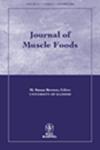RESPONSE SURFACE METHODOLOGY STUDY ON THE POSSIBILITY OF NITRITE REDUCTION BY GLUCONO-δ-LACTONE AND ASCORBIC ACID IN TURKISH-TYPE FERMENTED SAUSAGE (SUCUK)
Abstract
ABSTRACT
The primary goal of this study was to determine the residual nitrite-reducing effects of glucono-δ-lactone (GDL) and ascorbic acid (AA) in Turkish-type fermented sausage. Response surface methodology was used to investigate the simultaneous effects of processing variables, e.g., nitrite (0–200 mg/kg sausage), GDL (0–0.5% w/w) and AA (0–500 mg/kg sausage) on pH, moisture, residual nitrite, proteolysis, lipolysis, peroxide, yield and sensory score of the sausage. AA significantly (P < 0.01) decreased the residual nitrite level; however, quadratic effect of AA showed an inverse effect. GDL did not produce the same effect on the residual nitrite level. The processing variables had no prominent effect on the proteolysis, lipolysis and peroxide. GDL and AA addition showed a negative effect on the yield and sensory scores of the sausages. The regression model predicted the optimum residual nitrite content to be 0.75 mg/kg. The critical values for nitrite, GDL and AA to obtain this optimum level were 147.56 mg/kg, 0.17% and 565 mg/kg, respectively.
PRACTICAL APPLICATIONS
Residual nitrite level is a major problem in the Turkish-type fermented sausage product with respect to some health concerns, residual nitrite causes a possible formation of the carcinogenic N-nitrosamines. The results of this study can be applied to reduce the residual nitrite level in sausage and to find the optimum levels of nitrite, glucono-δ-lactone and ascorbic acid levels to maintain the characteristic sausage quality properties. Based on the results, ascorbic acid can be used to reduce the residual nitrite levels in the sausage.

 求助内容:
求助内容: 应助结果提醒方式:
应助结果提醒方式:


